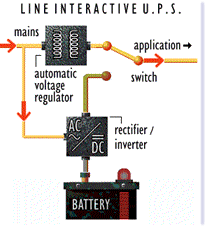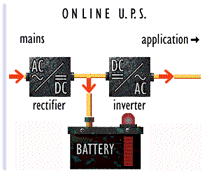STATIC UPS
|
There
are two basic types of static UPS on the market in today. They
are: line interactive and true on-line (double conversion). A
static UPS system usually consists of a battery to provide
continuous source of electrical power; a rectifier/charger to
maintain battery charge and to provide input to inverter when
utility power is available; an inverter to provide power to load
during normal operation; a static switch to transfer load
automatically and without disturbance between inverter and
utility power; a manual switch to bypass the static switch for
maintenance; input and output isolation transformers and filters
to provide appropriate isolation and disturbance attenuation;
and monitors, sensors, and control circuits.
|
|
Battery
power is a group of electro-chemical cells interconnected to
supply a nominal voltage of direct current (DC) power to a
suitable connected electrical load. The number of cells
connected in series determines the nominal voltage rating of the
battery is the basic factor that determines the discharge
capacity rating of the entire battery. The combination of the
charger and the battery becomes a system when it is connected to
an electrical load. The load is the equipment that draws DC
power from the charger and/or battery. The charger-battery load
combination is most efficient only when all of the components
are properly matched to each other. The charger converts
alternating current (AC) power into DC power that is compatible
with the battery’s voltage and current characteristics.The
charger is the converter section of the UPS which charges the
batteries and supplies DC to the inverter.
|

|
When the charger
and battery are connected permanently to each other and to the
load, and the charger regulates the voltage supplied to the load
and the battery, the system is known as a floating battery
system. The battery in such systems is mounted normally on a
rack or racks housed inside a building or enclosure. The load in
this case is the inverter.
The inverter provides three primary functions in the UPS.
Inversion is the changing of the DC power to AC power composed
of a sine wave free from harmful harmonic distortion [typically
5% total harmonic distortion (THD) or less]. The inverter also
provides regulation of the AC voltage to a tolerance level
acceptable to the load, typically +2 percent of the nominal
voltage.
|
|

|
PWM inverters
synthesize a sinusoidal output waveform from a constant height,
variable width high frequency pulse stream. The PWM inverter
configuration is referred to as an active regulator. Voltage and
current feedback loops gather downstream information and deliver
it to a microprocessor based control circuit through a series of
amplifiers. The bridge circuit in modern PWM technology normally
uses insulated gate bipolar transistors (IGBT) for power
switching, although, silicon controlled rectifiers (SCR) could
be used in
high capacity, lower frequency applications.The control circuit
adjusts the transistor conduction time based on the information
received from the voltage and current feedback loops to maintain
output regulation.
|
|
The driver network
is a parallel power or darlington transistor array. The positive
and negative pulse train is then coupled from primary to
secondary of a linear output transformer. A small
(line-commutated) LC filter with harmonic traps removes the odd
order harmonics from the pulse train to create a sine wave.
PWM inverters
offer many advantages when used in computer room applications,
including high efficiency due to the use of IGBTs and a linear
output transformer, small physical size, low cost, and rapid
response to transient load changes.
|
|
Sources:
- US Army
Corp of Engineers
- Labrijn Automotive and Industrial Products
- Powermatic Co. Ltd. |
|